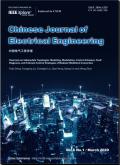Study on the Optimization for Reactive Power Regulation of Synchronous Condenser Based on Single Neuron Adaptive PID*
IF 3.5
Q1 Engineering
引用次数: 0
Abstract
A synchronous condenser (SC) is used to maintain grid voltage stability owing to its bidirectional fast reactive power regulation ability and good dynamic characteristics. To address the issue of dynamic voltage instability in power system during failures or heavy inductive loads, an SC reactive power regulation optimization method based on single neuron adaptive PID (SNA-PID) combined with whale optimization algorithm (WOA) is proposed. This approach aims to overcome the limitations of normal PID controllers. A simulation model of the SC reactive power regulation system, based on SNA-PID combined with the WOA, is established using Matlab. The parameters of the SNA-PID are optimized by the WOA with the ITAE criterion under two typical operation situations of the power system: one is to set three different degrees of short-circuit ground faults, and the other is to access three different three-phase resistive loads. Compared to conventional PID control, as the degree of short-circuit ground faults increases and the three-phase resistive load resistance decreases, the SC reactive power regulation optimization method based on SNA-PID combined with the WOA can still reduce the voltage recovery time and voltage oscillation, while maintaining voltage stability. Simulation results show that the proposed method exhibits better dynamic adjustment characteristics and adaptive ability.基于单神经元自适应PID的同步冷凝器无功调节优化研究*
同步电容器由于具有双向快速的无功调节能力和良好的动态特性,被用于维持电网电压稳定。针对电力系统在故障或重电感负载时动态电压不稳定的问题,提出了一种基于单神经元自适应PID (SNA-PID)和鲸鱼优化算法(WOA)相结合的SC无功调节优化方法。这种方法旨在克服普通PID控制器的局限性。利用Matlab建立了基于SNA-PID与WOA相结合的SC无功调节系统仿真模型。采用基于ITAE准则的WOA对SNA-PID参数进行了优化,优化结果适用于电力系统设置3个不同程度的短路接地故障和接入3个不同三相电阻性负载两种典型运行情况。与传统PID控制相比,在短路接地故障程度增加、三相电阻性负载电阻减小的情况下,基于SNA-PID结合WOA的SC无功调节优化方法仍能在保持电压稳定的同时减少电压恢复时间和电压振荡。仿真结果表明,该方法具有较好的动态调节特性和自适应能力。
本文章由计算机程序翻译,如有差异,请以英文原文为准。
求助全文
约1分钟内获得全文
求助全文
来源期刊

Chinese Journal of Electrical Engineering
Energy-Energy Engineering and Power Technology
CiteScore
7.80
自引率
0.00%
发文量
621
审稿时长
12 weeks
 求助内容:
求助内容: 应助结果提醒方式:
应助结果提醒方式:


